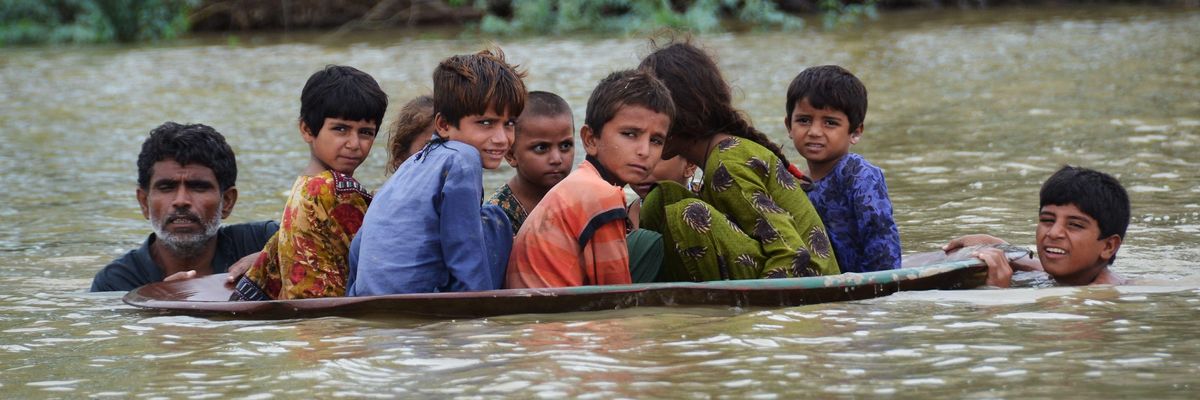Pakistan declared a national emergency on Friday as catastrophic monsoon rains, exacerbated by the fossil fuel-driven climate crisis, continued to pummel the country for the third consecutive month.
Since mid-June, flash floods and landslides across the South Asian nation have killed least at 937 people, injured more than 1,300, and destroyed well over half a million homes, according to the National Disaster Management Authority. In addition, nearly 800,000 livestock have died and at least 1,900 miles of roads and 145 bridges have been wiped out, disrupting the supply of food and further driving up prices.
"Thirty-three million have been affected in different ways. The final homeless figure is being assessed."
This is a "climate-induced humanitarian disaster of epic proportions," Sherry Rehman, the nation's climate change minister, told reporters on Thursday.
"Pakistan is going through its eighth cycle of monsoon while normally the country has only three to four cycles of rain," said Rehman. "The percentages of super flood torrents are shocking."
More than 100 districts across Pakistan's four provinces have been hit by flooding since the start of the monsoon season. The impacts have been especially devastating in the southern provinces of Sindh and Balochistan, which have received 784% and 496% more rain this month compared with the August average, according to the minister.
The two provinces have lost at least 306 and 234 people, respectively, and tens of thousands more have been forced to live in makeshift camps far away from their inundated cities and towns.
"Thirty-three million have been affected in different ways," said Rehman. "The final homeless figure is being assessed."
With the number of displaced people growing each day, the need for shelter and relief is "dire," Rehman added. According to the minister, Sindh recently requested one million tents from the federal government. Balochistan, already isolated from the rest of the country due to extensive damage to its transportation infrastructure, asked for 100,000 tents before losing communication with the rest of the country overnight.
Murad Ali Shah, the top elected official in Sindh, said earlier this week that the current situation is worse than what happened in 2010, when floods killed at least 1,700 people throughout Pakistan, mostly in his province. Fida Hussain Shahani, a worker from a remote village in Sindh who is mourning the death of his son, gave a similar assessment.
"Things were not so bad even in the 2010 floods," Shahani told Al Jazeera on Friday. "We never had to leave our village but this time, everything is destroyed."
"Yesterday, the flood water kept rising and entered our house," he continued. "While trying to reach high ground, my 17-year-old son was left behind. I only managed to find his body this morning."
Shahani told Al Jazeera that his family has yet to receive help from the government, with residents relying on the generosity of volunteers amid the ongoing deluge triggered by weeks of torrential rainfall.
In an appeal to the international community for immediate assistance, Rehman said Thursday that "it is beyond the capacity of any one administration or government to rehabilitate and even manage the rescue and relief."
On Friday, Prime Minister Shahbaz Sharif also asked the world to come to Pakistan's aid as quickly as possible. He convened a meeting with top humanitarian groups and foreign diplomats in the capital of Islamabad "as part of efforts to mobilize all resources."
As Reuters noted earlier this week, "Funding and reconstruction efforts will be a challenge for cash-strapped Pakistan, which is having to cut spending to ensure that the International Monetary Fund approves the release of much-needed bailout money."
Rehman, meanwhile, has warned that "Pakistan is under an unprecedented monsoon spell and data suggests the possibility of re-emergence of another cycle in September."
Ali Tauqeer Sheikh, an Islamabad-based climate expert, told Al Jazeera: "In 2010, the floods were riverine in nature, which means they mostly impacted areas around the Indus River and they were mostly predictable. This time, there are multiple types such as urban flood, flash flooding, and floods caused by glacier burst."
"What we are seeing here in the country is development deficit," said Sheikh. "It is not only the excessive rain which is causing the issue, but rather the inadequate preparation and infrastructure."
"Climate change," he added, "is a threat multiplier."
As Roxy Mathew Koll, a scientist at the Indian Institute of Tropical Meteorology, emphasized during last year's monsoon season, "the frequency and intensity of heavy rains has increased" as the warming Arabian Sea generates more cyclones and bigger downpours over shorter periods of time.
In addition, heatwaves of the sort that Pakistan and neighboring India endured this spring are accelerating glacial melt.
Related Content
IPCC Scientist Warns India-Pakistan Record Temps 'Testing Limits of Human Survivability'
Kenny Stancil
Recent studies warn that failing to slash planet-heating greenhouse gas pollution will make the monsoon season in South Asia stronger, less predictable, and more dangerous.
"Global warming... is dominating monsoon dynamics in the 21st century," according to Anja Katzenberger of the Potsdam Institute for Climate Impact Research and Ludwig-Maximilian University in Munich, Germany--the lead author of one of those studies.
"For every degree Celsius of warming," Katzenberger said last year, "monsoon rainfalls will likely increase by about 5%."


